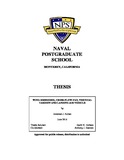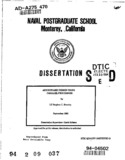Wing-embedded, cross-flow-fan, vertical takeoff and landing air vehicle
| dc.contributor.advisor | Hobson, Garth V. | |
| dc.contributor.advisor | Gannon, Anthony J. | |
| dc.contributor.author | Fulton, Jeremiah J. | |
| dc.date | 16-Jun | |
| dc.date.accessioned | 2016-08-02T19:34:59Z | |
| dc.date.available | 2016-08-02T19:34:59Z | |
| dc.date.issued | 2016-06 | |
| dc.identifier.uri | https://hdl.handle.net/10945/49464 | |
| dc.description.abstract | This research demonstrated that a vertical takeoff and landing aircraft capable of transitioning to conventional flight using cross-flow fans is possible. In particular, the design and manufacture of a wing-embedded cross-flow fan airfoil, and its implementation into an aircraft, was conducted. The design was developed based on the Gottingen 570 airfoil and generated lift coefficients of four--greater than the sum of the parts--due to the fundamental coupling between the wing and cross-flow fan. The wing was characterized with Ansys' CFX solver over tip-speed ratios of zero (hover) to infinity (glide), and predicted a hover angle of 36¼ with 56% of the lift coming from the airfoil. This meant that a full 90¼ rotation was not required to go from hover to forward flight; additionally, even while hovering, more than half of the lift was generated by the airfoil. The airfoil was manufactured from pre-impregnated carbon fiber using a mold produced by 3D printing. Printer filament selection was based on glass transition temperature and printability. ABS filament was chosen due to its high temperature resistance and relative ease of 3D printing. The aircraft was configured with all the wing assemblies facing the same direction to favor faster forward flight. This differed from previous designs, which used symmetry to increase stability. Controlled untethered flight was successful. | en_US |
| dc.description.uri | http://archive.org/details/wingembeddedcros1094549464 | |
| dc.publisher | Monterey, California: Naval Postgraduate School | en_US |
| dc.rights | This publication is a work of the U.S. Government as defined in Title 17, United States Code, Section 101. Copyright protection is not available for this work in the United States. | en_US |
| dc.title | Wing-embedded, cross-flow-fan, vertical takeoff and landing air vehicle | en_US |
| dc.type | Thesis | en_US |
| dc.contributor.department | Mechanical and Aerospace Engineering | en_US |
| dc.contributor.department | Mechanical and Aerospace Engineering (MAE) | |
| dc.subject.author | heavy lifting aircraft | en_US |
| dc.subject.author | air vehicle | en_US |
| dc.subject.author | propulsive wing | en_US |
| dc.subject.author | wing embedded | en_US |
| dc.subject.author | cross-flow fan (CFF) | en_US |
| dc.subject.author | vertical takeoff and landing (VTOL) | en_US |
| dc.subject.author | horizontal takeoff and landing | en_US |
| dc.subject.author | 3D print mold | en_US |
| dc.subject.author | additive material manufacture | en_US |
| dc.subject.author | prepreg carbon fiber layup | en_US |
| dc.subject.author | pre-impregnated | en_US |
| dc.subject.author | controller stabilized | en_US |
| dc.description.recognition | Outstanding Thesis | en_US |
| dc.description.service | Ensign, United States Navy | en_US |
| etd.thesisdegree.name | Master of Science in Mechanical Engineering | en_US |
| etd.thesisdegree.level | Masters | en_US |
| etd.thesisdegree.discipline | Mechanical Engineering | en_US |
| etd.thesisdegree.grantor | Naval Postgraduate School | en_US |
| dc.description.distributionstatement | Approved for public release; distribution is unlimited. |
Files in this item
This item appears in the following Collection(s)
-
1. Thesis and Dissertation Collection, all items
Publicly releasable NPS Theses, Dissertations, MBA Professional Reports, Joint Applied Projects, Systems Engineering Project Reports and other NPS degree-earning written works. -
2. NPS Outstanding Theses and Dissertations





